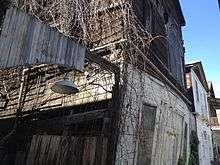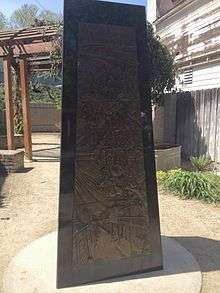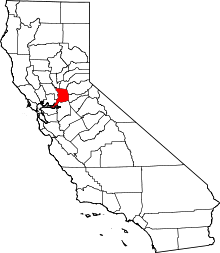Locke, California
|
Locke Historic District | |
|
The main street of Locke, in 2006, has some Chinese shops among habitations. | |
  | |
| Location | Bounded on the W by the Sacramento River, on the N by Locke Rd., on the E by Alley St., and on the S by Levee St., Locke, California |
|---|---|
| Coordinates | 38°15′2″N 121°30′34″W / 38.25056°N 121.50944°WCoordinates: 38°15′2″N 121°30′34″W / 38.25056°N 121.50944°W |
| Area | 14 acres (5.7 ha) |
| Built | 1915 |
| Architectural style | Neo-Gothic, Other |
| NRHP Reference # | 71000174[1] |
| Significant dates | |
| Added to NRHP | May 06, 1971[1] |
| Designated NHLD | December 14, 1990[2] |
Locke (traditional Chinese: 樂居; simplified Chinese: 乐居; pinyin: Lèjū; Jyutping: Lok6geoi1), also known as Locke Historic District, is an unincorporated community in California's Sacramento–San Joaquin River Delta built by Chinese immigrants during the early 20th century. It was originally named Lockeport after George Locke, who owned the land that the town was built upon at a time when Chinese people were not allowed to own land. Locke is located in the primarily agricultural region south of Sacramento, California, near State Route 160. It was listed on the National Register of Historic Places in 1971 and further was designated a National Historic Landmark District in 1990 due to its unique example of a historic Chinese American rural community.[2]
Description
The ZIP Code is 95690, and the community is inside area code 916.
History



Legislation such as the Swampland Reclamation Act of 1861 was enacted in California to put perceived empty and wasted lands to use and stabilization.[3] Much of this involved draining the Delta wetlands and building levees to regulate flood control in places like Locke.[3] Mainly poor Chinese immigrants were hired to do this backbreaking reclamation work.[4] Through contracted labor often equaling less than one dollar a day per worker, they built hundreds of miles of levees in waist deep water where malaria still rampaged, reclaiming a total 88,000 acres.[4]
The original beginning of Locke, then called Lockeport, was in 1912, when three Chinese merchants, two from the nearby town of Vorden and one from Walnut Grove, contracted tradesmen to construct three buildings. Chan Tin Sin built the first building. It was a combination dry goods store and beer saloon. Yuen Lai Sing built a gambling hall. Owyang Wing Cheong built the Lockeport Hotel & Restaurant.[5][6]
Following that early construction the Canton Hotel was built, along with several other buildings, one of which later became a bordello. A total of seven structures eventually formed the hamlet of Lockeport. Though some merchants hoped to provide a destination for riverboat and train passengers, the idea never worked due to the discrimination against Chinese during those times.[7] One of the homes built in the first phase of construction provided shelter for Chan Tin Sin's cousin Chan Chor Get and his family from the discriminatory acts and violence in San Francisco Chinatown.[8]
On October 7, 1915,[9] the Chinatown of nearby Walnut Grove was destroyed and burned after an accidental fire thus causing a migration of Zhongshan district Chinese into neighboring areas. Afterwards, the Main Street section of the town of Locke was settled and established by a group, headed by Lee Bing, of Chinese/American Businessmen Yuehai-speaking Chinese (a dialect of Yue Chinese) from the Zhongshan region of Guangdong province in China. Differing in some respects from the predominant Toisanese Chinese-speakers in practice, they created a town of their own. The land was leased from George Locke as California law at the time forbade the selling of farmland to Asian immigrants by the California Alien Land Law of 1913. Many Chinese immigrants were facing serious discrimination in the major cities. It is a town built completely "by the Chinese for the Chinese" and can be considered a distinct rural Chinatown enclave. Like many other Chinatowns, it had a Chinese-language school, general stores, and restaurants. Because of its relatively large population of Chinese people at the time, the Chinese Kuomintang political party once had a local chapter in Locke. As the town grew, so did its reputation as a destination for illicit entertainment, gaining the nickname "California's Monte Carlo". At one point, it had five gambling halls, five brothels, speakeasies and opium dens.[10]
The population of Locke swelled with the growing season and harvest. Most of the reclaimed land in the Sacramento-San Joaquin Delta including Locke was used for cash crops, including asparagus, potato, sweet potatoes, white beans, pears, and apples.[4] There would be as many as 1000 to 1500 Chinese people living in Locke. Farmhands shared rooms in the boarding houses. Chinese residents living in the homes behind Main Street also took in Chinese farm laborers. Chinese immigrants in Locke started patterns in California agriculture that are continued today in the Sacramento-San Joaquin region, including contracted labor, tenant farming, sharecropping, and the piece wage system.[4] A community garden existed in the back and there was a special oven to make roast pigs on Sundays. Chinese communities congregated in solidarity under difficult labor and social conditions fostered by legislation such as the Chinese Exclusion Act, creating community gardens that maintained cultural relevancy in the form of growing Chinese cabbage, snow peas, leafy vegetables, winter melon, and tomatoes.[4] Baptist missionary Dr. Charles Shepherd would bring in his Chungmei home boys for the pear harvest at the end of July. Life in Locke had a great deal of accord. The Chinese mothers took care of each other's children when another mother had to go to work at the cannery across the River Road next to the riverboat docks of the Sacramento River.[7]
Ironically, however, the current population of Locke is predominantly white, and the population of Chinese Americans (i.e., descendants of the town's original settlers) is 10. During the 1940s and 1950s, many of Locke's Chinese Americans, many of whom received better education, began joining the American mainstream by moving out of rural Locke and into the burgeoning suburbs of the major cities.
The Locke Historic District bounded on the west by the Sacramento River, on the north by Locke Rd., on the east by Alley St., and on the south by Levee St. The district was added to the National Register of Historic Places on May 6, 1971.[1]
A Hong Kong-based developer purchased the town in 1977 from the Locke Heirs and sold it in 2002 to the Sacramento Housing and Redevelopment Agency. In 2004, the agency finally allowed the sale of land to those who had been living on it for many years. There were plans to convert Locke into a housing development and tourist attraction. At the north end of Main Street, the restored Locke Boarding House museum (now owned by California State Parks) operates daily, staffed by volunteers. The Town of Locke celebrated its centennial anniversary in 2015, with a large gathering on May 9.
On July 3, 2016, a fire erupted on the second floor of the Locke Country Store on Main Street, which contained two apartments. The fire resulted in the complete destruction of the second floor of the building and a building behind the store. There were no injuries.[11]
The Locke Historic District was designated a National Historic Landmark on December 14, 1990.[2][12]
Politics
In the state legislature, Locke is in the 5th State Senate district, represented by Democrat Lois Wolk, and in the 15th State Assembly district, represented by Democrat Joan Buchanan.
Federally, Locke is in California's 3rd congressional district, represented by Democrat John Garamendi.[13]
Books
Locke is the subject of the following books:
- Bitter Melon: Inside America's Last Rural Chinese Town by Jeff Gillenkirk and James Motlow (Nine Mile Press). Winner of the Commonwealth Club's 57th Annual Book Award, Silver Medal
- One Day, One Dollar: Locke, California, and the Chinese Farming Experience in the Sacramento Delta by Peter C. Y Leung.
- Water Ghosts (a novel) by Shawna Yang Ryan.
References
- 1 2 3 National Park Service (2010-07-09). "National Register Information System". National Register of Historic Places. National Park Service.
- 1 2 3 "Locke Historic District". National Historic Landmark summary listing. National Park Service. Retrieved 2008-02-13.
- 1 2 Hundley, Norris (2001). The Great Thirst: Californians and Water- A History. Berkeley: University of California Press.
- 1 2 3 4 5 Leung, Peter (1984). One Day, One Dollar: Locke, California, and the Chinese Farming Experience in the Sacramento Delta. El Cerrito, California: Chinese/Chinese American History Project.
- ↑ Dedicatory plaque on the first building, Locke, California, Sacramento County Historical Society, August 2, 1970.
- ↑ "A History of Chinese Americans in California: Historic Sites, Locke" in Five Views: An Ethnic Historic Site Survey for California (California Office of Historical Preservation, December 1988).
- 1 2 Oral interviews by Roberta (Bobbie) Owyang-Lee, daughter of Owyang Wing Cheong.
- ↑ Oral interview by Jane Chan-Chung, daughter of Chan Chor Get.
- ↑ Testimony of Walnut Grove and Locke merchant Owyang Tin Git, Chinese Exclusion Act Case Files, ca. 1882 - ca. 1960, Record Group 85: Records of the Immigration and Naturalization Service, 1787 - 2004, National Archives & Records Administration, Washington, DC.
- ↑ Magagninismagagnini, Stephen (2015-05-07). "Locke, once 'Monte Carlo of the State,' celebrates 100th birthday | The Sacramento Bee". Sacbee.com. Retrieved 2016-07-03.
- ↑ Kalb, Loretta; Hice, Jessica (2015-07-04). "Fire, screams, then a ladder to the rescue in Locke; The Sacramento Bee". Sacbee.com. Retrieved 2016-07-31.
- ↑ James H. Charleton (June 21, 1990). "National Register of Historic Places Registration: Locke / Locke Historic District" (PDF). National Park Service. Retrieved 2009-06-22. (includes map) and Accompanying photos, exterior and interior, from 19. (1.14 MB)
- ↑ "California's 3rd Congressional District - Representatives & District Map". Civic Impulse, LLC. Retrieved March 9, 2013.
Further reading
- Bitter Melon: Inside America's Last Rural Chinese Town by Jeff Gillenkirk and James Motlow (Nine Mile Press, San Francisco, CA)
External links
| Wikimedia Commons has media related to Locke, California. |
- Locke, California - Official site with in-depth history
- Locke and Walnut Grove: Havens for Early Asian Immigrants in California Teaching with Historic Places Lesson Plans from the National Park Service
- Five Views: An Ethnic Historic Site Survey for California
- Nancy Wey papers, 1850-1994


.svg.png)